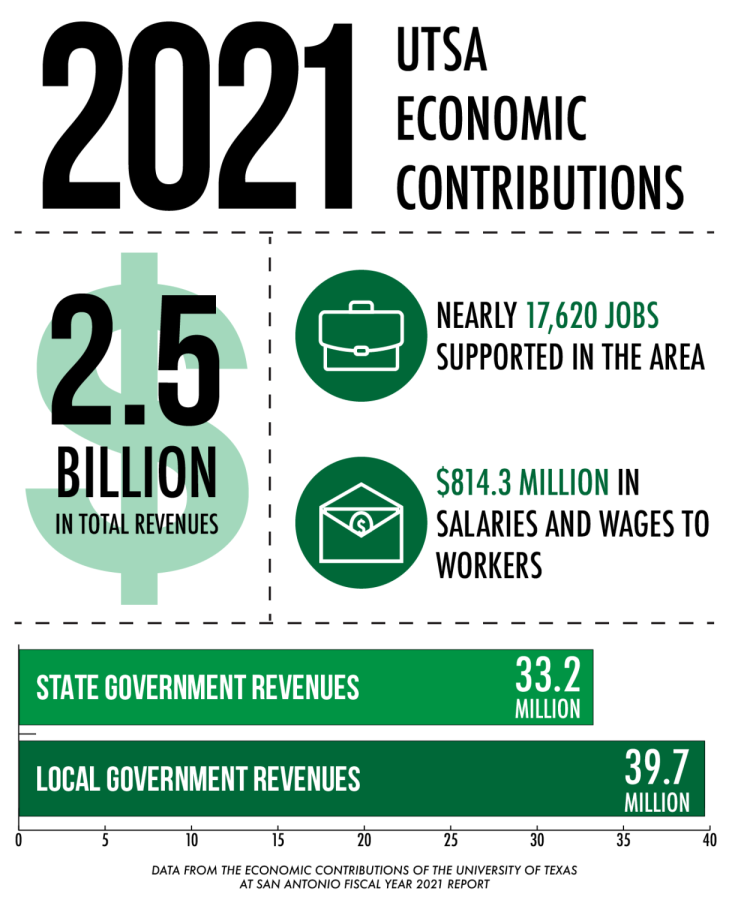University reports $2.5 billion total output contribution to San Antonio economy in FY21
April 25, 2023
UTSA contributed a total output of $2.5 billion to the Greater San Antonio economy in the 2021 fiscal year, a 30% jump over the last three years per the recently released “Economic Contributions of The University of Texas at San Antonio Fiscal Year 2021 report.”
Javier Oyakawa, senior economist at the UTSA Institute of Economic Development (IED), and Tom Tunstall, senior director of the Center for Community and Business Research at the IED, worked on the report, which measured the university’s “contribution and impact” in four different categories for FY 2021. These categories include out-of-the-area student expenditures and spending, operations and maintenance expenditures, including salaries and wages, capital and construction expenditures, and the community engagement work of the university’s IED.
University officials and staff members also helped with the collection of information needed.
“The first two weeks were very intense in order to get information from different sources,” Oyakawa added. “Then, [we had to] process the data and make it appropriate for the software that we use and that’s very time-consuming.”
The economic report is the third of its kind that Oyakawa has worked on.
According to Oyakawa, the university requested an economic impact report to present the information to the Texas legislature, which is currently in session. As a public institution, UTSA receives funding from the legislature.
“This information was requested by the officials of the university to help in the process of making the case [that] UTSA needs [funding],” Oyakawa said.
According to UTSA Today, all spending was recorded for the San Antonio Metropolitan Statistical Area, which includes eight counties — Atascosa, Bandera, Bexar, Comal, Guadalupe, Kendall, Medina and Wilson.
“For 2021, it was important to include the eight counties that make up the San Antonio Metropolitan Statistical Area because these eight counties make up an economic unit [as defined by the Bureau of Labor Statistics],” Oyakawa said. “[These counties] are related to Bexar county, so that’s why since 2008 we decided to use this area of analysis and not just Bexar county.”
The university’s operating expenditure, which includes wages and salaries for faculty and staff and research and development programs spending, generated a “total output contribution” of $1.1 billion. Additionally, the university’s expanding downtown footprint generated a total output contribution of $112.9 million.
With regard to student expenditures, only the data for out-of-SAMSA and international students was utilized. These expenses accounted for $298 million of the university’s total output impact.
“The expenditures of these students coming from these areas outside are called “new money,” Oyakawa said. “They have relevant impact or contributions in the area of analysis. That’s why we make this distinction. It’s very important for the methodology of the economic impact analysis.”
Furthermore, UTSA’s designation as an R1 institution in 2021 also contributed to this rise. According to UTSA Today, the university’s research spending for FY 2021 totaled $140 million, a 106% rise from $67.8 million in FY 2017.
“It is so important to report these economic contributions for 2021 because it really marks a very important piece of history for the university,” Oyakawa said.
Finally, the university’s IED was able to help its clients generate a total output contribution of $944.4 million through its “growth services and counseling to small businesses in San Antonio and South Texas.”
For more information about the IED, visit iedtexas.org/.













